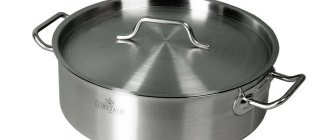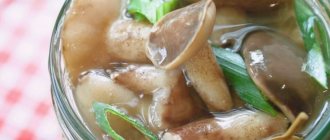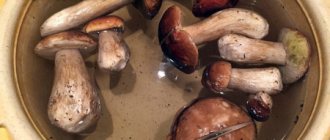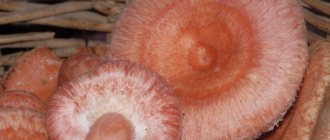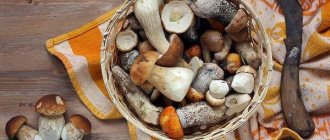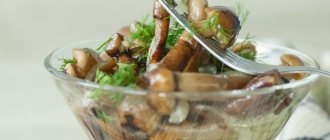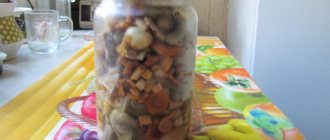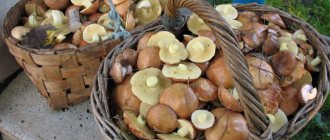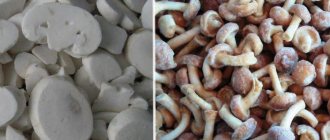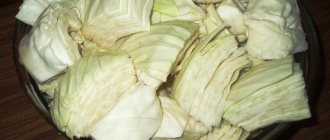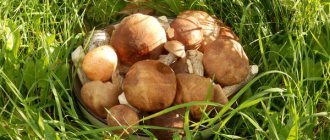This summer of 2015 is simply amazing for the harvest of berries and mushrooms. On the first of August, I picked a one and a half liter jar of blueberries from a thrice-picked clearing. The mushrooms didn’t disappoint either, but the milk mushrooms were especially impressive.
We must immediately warn you that no matter how talented a cook you are, the most important thing in pickling mushrooms is to have a place to store them. Mushrooms can be infused without problems only in a deep, cold cellar, where it is 4-5 degrees. Putting them for pickling in an apartment, pantry, or on the balcony is a thankless task.
There are many recipes for salting milk mushrooms; I salted them cold, as my grandfather taught me.
So, before cooking milk mushrooms, they need to be thoroughly soaked in cold water. Ideally, 5-7 days, changing the water twice a day every day - it becomes slimy, it can simply ferment or sour, especially if it’s warm, but the main thing is that soaking is needed to get rid of the bitterness.
If there is fine forest debris on the mushrooms, it will get wet and fall off. We thoroughly rinse the milk mushrooms one last time in cold water until they are completely clean. You can salt in any container except metal. If there are not very many mushrooms - in a plastic bucket or small wooden barrel. If there are a lot of mushrooms, they are pickled in large barrels, adding new batches of mushrooms.
It is advisable to choose a container for pickling with a wide neck. I use a regular 10 liter plastic bucket for pickling.
Marinade for milk mushrooms
- coarse rock salt, non-iodized
- garlic
- dill umbrellas
- horseradish leaves
But you don’t need water yet. That is, this is not a ready-made marinade - it is formed during the infusion process, since mushrooms contain a lot of water.
At the bottom of the bucket we put horseradish leaves, dill, a few cloves of garlic and pour a handful of salt, about a tablespoon. The calculation of salt for milk mushrooms is as follows: approximately 40-50 g per 1 kg of mushrooms.
Now take the washed mushrooms and squeeze them thoroughly between your palms - no extra water is needed.
Place the mushrooms, caps down, in an even layer and sprinkle with salt. For each layer of mushrooms I use a flat spoon of salt or a dessert spoon. Add garlic cloves and dill sprigs again.
Next, lay it out in layers, squeezing the mushrooms each time, squeezing them between your palms. To the very top of a bucket or other container. Place large mushrooms in one layer, small ones in three to four layers. Place horseradish leaves on top again to cover all the mushrooms. They also need to be salted. It is advisable to put a piece of clean linen fabric or any other cotton fabric on top.
Important: now you need to choose a plate of such a diameter that it just fits into the bucket easily. But the plate must be flat, not soup-deep - otherwise emptiness and mold will form under the hump of the plate. Cover the mushrooms with a plate turned upside down and press down. As a pressure, you can use a large washed (calcined) stone, a jar of water, but I use a 5-liter canister of water.
Leave the mushrooms in a cool place in the apartment for 2 days. During this time, the mushrooms will settle under pressure and become compacted, then it will be possible to add another layer of mushrooms, and if excess water forms, drain it. If we report mushrooms, we leave them at home for another 2 days. Let's see if there is enough liquid and if the load is suitable. It is very important that the mushrooms are completely covered with liquid. They didn’t swim in it, but they didn’t stick out from above. If the brine does not release under the load after 2 days, there is no need to add water, you need to change the load to a heavier one. Wait another 2 days and only if the brine does not appear, add saline solution (1 tablespoon of salt per 1 liter of water). Then you can transfer the mushrooms to the cellar for storage. I put a clean bag over the structure of the bucket with the load to prevent dust from flying. Milk mushrooms are salted for 1.5 months.
Is it possible to pickle mushrooms in plastic containers?
Of course, if you live in places where mushrooms are almost the second bread, then you should have a good supply of tubs and barrels. But if the mushroom harvest is breaking records or you are collecting and preparing mushrooms for the first time, the issue with containers may turn out to be serious.
Let's start by listing the types of containers that should definitely be excluded from the list, then we will find out in which container it is better to salt mushrooms. So, we never use:
- Galvanized buckets and tanks.
- Enameled dishes with traces of chips.
- Clay pots, including those coated with glaze.
- Dishes made of aluminum and its alloys.
- Plastic containers not intended for food products.
- Wooden dishes that retain the persistent smell of previous pickles.
Perhaps it is unnecessary to clarify the reasons for such selection, let’s just say about pottery. In principle, the material itself does not affect the quality of the mushrooms, but the brine, on the contrary, greatly destroys the clay. In addition, decorative glaze may contain lead components, which is extremely hazardous to health.
Is it possible to pickle mushrooms in plastic containers? Yes, this is acceptable, although it is not the best choice. It is much safer to use wooden or glass containers, but in a pinch, food grade plastic will do.
Not every plastic container that previously contained food is suitable for pickling. The industry does not produce special plastic containers in the expectation that blanks will be produced in them. Whether it is possible to salt in a plastic container depends on the quality of the material from which it is made.
The most durable and safest type of food-grade plastic is polypropylene. Most types of cookware intended for hot dishes or heating them are made from it. Such products are marked with a special icon - two Latin letters “PP”. You can count on the brine not harming this material.
Is it possible to pickle mushrooms in a polypropylene plastic bucket? Yes, but there are some restrictions here too. For example, despite the heat resistance of this type of plastic, harvesting mushrooms using hot brines is undesirable. The fact is that in addition to high temperature, polypropylene will also be affected by an aggressive acidic-salty environment, and it is not easy to predict the result in this case.
Plastic containers, provided they meet the requirements, are inexpensive and convenient. They are suitable, for example, for pre-treatment. For example, you will have to decide for yourself whether it is possible to salt milk mushrooms in a plastic bucket, but repeated soaking of these mushrooms in cold water is convenient to do in plastic containers.
If you have a wide variety of types of mushrooms, then plastic containers can be used at the first stage of preparation. Some mushrooms are salted quickly enough and you can use plastic buckets or barrels at first, and then package the preparations in more suitable containers.
Is it possible to salt saffron milk caps in plastic containers and then store them in glass containers? Yes, and it's very convenient. Having aged the mushrooms according to the recipe, they are then simply transferred together with the brine into bottles or jars and sent for long-term storage in a cool room or refrigerator.
Is it possible to pickle mushrooms in plastic containers?
In general, it is customary to use glass or wooden containers for pickling mushrooms. But, if you don’t have one, you can use plastic food containers for hot dishes. Such utensils are more or less suitable for pickling mushrooms, since they are less susceptible to various liquids and do not emit harmful substances (that’s why they are food utensils). But it’s still better to salt mushrooms in glass jars.
Salted mushrooms are our family's favorite delicacy. I never use plastic containers for pickling. No matter how reliable the marking may be, salting is a long process and sooner or later, the aggressive environment of the brine will do its job. Plastic, even the most resistant one, will react with the salty contents and turn from a tasty and healthy product into a real poison. No matter how the manufacturers of plastic utensils convince us of their safety, it is still worth thinking a hundred times before salting or fermenting anything in it. Even just storing food for a long time is not recommended. When buying the same vinegar, I immediately pour it into a glass bottle, or immediately on the store shelf I will give preference to the product in a glass container rather than in plastic. And it is best to salt mushrooms in wooden barrels, as our mothers and grandmothers did. This is the most ideal container for pickling and fermenting.
In general, it is customary to use glass or wooden containers for pickling mushrooms. But, if you don’t have one, you can use plastic food containers for hot dishes. Such utensils are more or less suitable for pickling mushrooms, since they are less susceptible to various liquids and do not emit harmful substances (that’s why they are food utensils). But it’s still better to salt mushrooms in glass jars.
Is it possible to pickle mushrooms in stainless containers?
Yes, but it’s worth clarifying the requirements for the dishes a little. When it comes to stainless steel, be careful! Not all types of such metal are safe to come into contact with food. If you use store-bought utensils, they will not harm you and there is no need to worry. It's another matter if you use handmade troughs or bathtubs.
You need to be sure that such containers are made of metal designed for use in contact with food. Thus, is it possible to salt mushrooms in a stainless pan - yes, but only if it is made of a special grade of steel.
It is important to understand that not all stainless steel containers are equally suitable for pickling vegetables and mushrooms. Often pans, including quite large ones, are made from food-grade aluminum. It is convenient to cook food in them, but such utensils are not suitable for pickling. Aluminum oxidizes easily, especially when in contact with brines and marinades. The compounds released during this process spoil the products and are considered unsafe for humans. As a consequence of this: is it possible to pickle mushrooms in aluminum dishes? Unfortunately no.
Homemade pickles are the best snack in the winter, because they are always prepared from the highest quality, natural products and always with soul. But this is not enough, because not a single pickle will be stored for long if you do not follow the cooking rules.
Mushrooms are a product that requires special attention when preparing for the winter. Housewives always have a lot of questions: is it possible to pickle mushrooms in a plastic container; how much salt is required; which method is better - hot or cold; How soon can you eat salted mushrooms, etc. All answers can be found in this article.
How to pickle mushrooms in a pan under pressure: the hot method
Tubular and lamellar mushrooms are most suitable for pickling. The second type includes honey mushrooms, which are often chosen for harvesting for the winter due to their small size. Honey mushrooms can be salted whole, so the appetizer is not only tasty, but also beautiful. Learn how to pickle mushrooms using the hot method.
Important: do not salt mushrooms in a stainless steel or aluminum pan, as they react with the metal and release toxic substances. Use an enamel pan.
- Honey mushrooms 2 kg
- Salt 100 g
- Black peppercorns 10 pcs.
- Bay leaf 3 pcs.
- Dill umbrellas 8 pcs.
- Cherry leaves 10 pcs.
- Currant leaves 10 pcs.
- Garlic 6 cloves
- Horseradish leaves 3 pcs.
Important: if you are salting milk mushrooms - white or black milk mushrooms, volnushki, white mushrooms, valui, podoreshniks, smoothies, violins - they must first be soaked for 1-2 days in water with a small amount of citric acid. The water needs to be changed several times during this time.
How to pickle cucumbers for the winter in a 5-liter bottle
You should collect all the necessary ingredients and a couple of five-liter containers, and all preparations for appetizers for hot dishes are completed. Any spices to taste are added to the recipe: they will add original notes to the preparation. Using a similar procedure, you can salt tomatoes and eggplants in five-liter barrels.
Ingredients
The beauty of this recipe lies in the availability of its ingredients. You can get them in any, even small store.
For one five-liter bottle you will need:
- pickling cucumbers - 3 kilograms;
- currant leaf - 1 piece;
- bay leaf - 1 piece;
- bell pepper - 2 pieces;
- an umbrella of fresh dill and its stem - 1 piece each;
- black peppercorns - 6 pieces;
- horseradish - 1 leaf or 1 cm of root.
- garlic - 6 cloves.
For the brine you will need:
- 1 liter of spring water;
- 40 grams of coarse non-iodized salt.
Usually the preparation takes about 20 minutes, and the preparation of the preserve itself takes 7 days.
Preparation
A five-liter container will save a lot of time and add new sensations to the usual process of pickling cucumbers.
- Wash the cucumbers, peel the back parts, immerse in a bowl of cold water and leave for 20 minutes.
- Time to prepare the remaining ingredients. Rinse the bell pepper well, remove the core and cut into four pieces. Wash horseradish and dill and chop coarsely.
- Remove the peel from the garlic and rinse it under running water.
- Place chopped pepper, garlic, dill and horseradish into clean five-liter containers. Add currant leaf. Place cucumbers on top. Lastly, add the peppercorns and bay leaf.
- Then take a large, deep container (even a basin will do) and pour water into it, mix it with salt until completely dissolved.
- Add water to the bottles with cucumbers. Tighten the lids well and put them in a dark, cool place.
- The readiness of the snack is determined by the foam that forms under the lid. If it appears, you can proceed to the final stage of preparation. This usually happens within 5-7 days.
- When this happens, the cucumbers must be washed. To do this, you need to drain the fermented water, pour clean water into plastic containers and shake. Repeat the procedure several times.
- For this, spring water, which is in bottles upon purchase, will come in handy. It can first be poured into another container and then used.
- In order for pickled fruits to be easily removed from a five-liter bottle, it is recommended to cut its upper edge.
We recommend reading: Pour boiling water over honey mushrooms overnight
Salting saffron milk caps using a cold method under pressure
How to pickle mushrooms cold? The recipe is simple. For pickling, let's take one of the most suitable varieties for this - saffron milk caps.
Cooking time: 1 hour
Number of servings: 15
Energy value of the product
- proteins – 2.4 g;
- fats – 1 g;
- carbohydrates – 0.5 g;
- calorie content – 20 kcal.
Ingredients
- saffron milk caps – 2 kg;
- salt – 100 g;
- allspice peas – 30 pcs.;
- garlic – 4 cloves;
- bay leaf – 20 pcs.;
- black currant leaves – 20 pcs.
Cooking process
- Sort the saffron milk caps, discard the rotten and wormy fruits. Cut off the bottom of the stem of the mushrooms. Place the saffron milk caps in a colander and rinse thoroughly with cold water under the tap.
- Prepare a soaking solution. Fill a large container with drinking water, dissolve salt and citric acid in it at the rate of 10 and 2 g per liter, respectively. Place the saffron milk caps in this solution and soak for two days. The solution needs to be changed several times during this time.
- After this, rinse the mushrooms again under running water. Place on a paper towel to remove excess moisture.
- Select an enamel pan of suitable volume. Place currant leaves, bay leaves, allspice and garlic on the bottom. First cut each clove into two parts. Sprinkle with half the total amount of salt.
- Place the mushrooms in the pan, caps up, and sprinkle with the remaining salt. Cover the contents of the pan with gauze and apply pressure. After a few hours, the saffron milk caps will compact a little and you can add another batch of mushrooms to them, if they all don’t fit into the pan at once.
- Leave the saffron milk caps like this for two weeks. The temperature in the room where they are located should be no higher than 20 degrees. Change the gauze that covers the mushrooms every few days.
- After this time, the oppression can be removed and the salted saffron milk caps can be placed in sterilized jars. Or you can cover with a lid and leave them in the pan.
What is the customary method for salting mushrooms?
Three-liter glass jars are quite suitable for pickling mushrooms.
In ancient times, pickling foods was very popular. For this, huge tubs made of wood or clay were used.
Today, stores sell special wooden tubs of different sizes and at different prices. It is believed that pickled mushrooms in wooden barrels acquire a unique, refined taste. If there is no money for such pleasure, we make do with what we have at home.
Glass jars, enamel pots, and buckets are also suitable here. There are two types of pickling: cold and hot. In the second option, the sorted and washed mushrooms are boiled for about 10 minutes, then placed in a colander (to drain the water).
It is recommended to follow a few simple salting rules:
- Wooden chips can be placed on the bottom of the container;
- Place currant or horseradish leaves on the wood chips;
- change the water in the mushrooms every 2-3 days;
- do not forget to cover the top with greens and press down with a strong weight; if there is no pressure, the mushrooms will float, come into contact with air and as a result will sour;
- The container with mushrooms should be kept in a cool place - in the refrigerator or on the balcony if the outside temperature is not too high.
Is it possible to pickle mushrooms in plastic containers?
To ensure a long shelf life for mushrooms, you should take care of the container in which you salt the mushrooms. Often during the harvesting season, all suitable buckets and pans are occupied with something. Experienced housewives know that mushrooms and vegetables need to be salted in wooden, glass or enamel containers. But sometimes only plastic is left on the farm. Is it possible to pickle mushrooms in it?
You should not prepare pickles in plastic containers. Salt has a destructive effect on plastic, causing the material to release toxic substances that penetrate the food. But if this is the only vessel that is currently available for pickling, carefully inspect it and prepare it thoroughly.
How to prepare plastic containers
The first thing you need to look for on plastic utensils when inspecting them is a special symbol that shows a fork and a glass. This sign indicates that the container is suitable for storing food.
Plastic utensils may also have additional symbols indicating the specific purposes for which they can be used:
- a plate with a shower that waters it - dishwasher safe;
- snowflakes - suitable for freezing food in it;
- oven with waves - suitable for heating food in the microwave.
- PET – polyethylene terephthalate;
- HDP - high-strength polyethylene;
- PVC – polyvinyl chloride;
- LDP - low density polyethylene;
- PP - polypropylene;
- PS - polystyrene.
PVL, PP, PS and PET are plastics suitable for food storage. The remaining markings mark plastic that is used in construction, industry, and intended for other household purposes.
There is no categorical ban on the use of plastic utensils when pickling mushrooms. But if possible, it is better to refuse it. As a last resort, use it only during the pickling process, and when the mushrooms are ready, transfer them to sterilized glass jars for storage. Good luck with your preparations, delicious pickles and bon appetit!
Did you like the recipe? Save it to your Pinterest! Hover over the image and click “Save.”
Homemade pickles are the best snack in the winter, because they are always prepared from the highest quality, natural products and always with soul. But this is not enough, because not a single pickle will be stored for long if you do not follow the cooking rules.
Mushrooms are a product that requires special attention when preparing for the winter. Housewives always have a lot of questions: is it possible to pickle mushrooms in a plastic container; how much salt is required; which method is better - hot or cold; How soon can you eat salted mushrooms, etc. All answers can be found in this article.
Is it possible to pickle wild mushrooms in a plastic bucket?
Is it possible to pickle mushrooms in a plastic bucket? This question interests many housewives. The summer period and the beginning of winter for many housewives are spent preparing for winter, namely: pickling, seaming and pickling various vegetables and fruits. After all, in winter, sometimes you really want something tasty, fruit or vegetable.
It is recommended to pickle mushrooms in glass or enamel containers with intact enamel, as well as in wooden tubs.
Of course, you can just go to the supermarket and buy juice or canned cucumbers, or pickled mushrooms. But how can you compare a store-bought product, produced in an unknown place and by an unknown person, with delicious snacks prepared by the caring hands of our mothers and grandmothers!
The canning process takes a certain amount of time and effort, but it's worth it. And when jars with various jams and salads are already located on the shelves in the cellar, and there is no longer enough dishes for anything, the mushroom period begins. With the onset of the mushroom season, housewives are faced with the question of whether it is possible to pickle mushrooms in a plastic bucket. Someone might ask rhetorically: “Are there really no other dishes left in the house?” But this also happens - cabbage is still being fermented there, something else is busy here. I really want some salty mushrooms for the winter, but there aren’t enough dishes.
How to pickle mushrooms in a pan under pressure: the hot method
Tubular and lamellar mushrooms are most suitable for pickling. The second type includes honey mushrooms, which are often chosen for harvesting for the winter due to their small size. Honey mushrooms can be salted whole, so the appetizer is not only tasty, but also beautiful. Learn how to pickle mushrooms using the hot method.
Important: do not salt mushrooms in a stainless steel or aluminum pan, as they react with the metal and release toxic substances. Use an enamel pan.
- Honey mushrooms 2 kg
- Salt 100 g
- Black peppercorns 10 pcs.
- Bay leaf 3 pcs.
- Dill umbrellas 8 pcs.
- Cherry leaves 10 pcs.
- Currant leaves 10 pcs.
- Garlic 6 cloves
- Horseradish leaves 3 pcs.
Important: if you are salting milk mushrooms - white or black milk mushrooms, volnushki, white mushrooms, valui, podoreshniks, smoothies, violins - they must first be soaked for 1-2 days in water with a small amount of citric acid. The water needs to be changed several times during this time.
Is it possible to pickle mushrooms in plastic containers?
To ensure a long shelf life for mushrooms, you should take care of the container in which you salt the mushrooms. Often during the harvesting season, all suitable buckets and pans are occupied with something. Experienced housewives know that mushrooms and vegetables need to be salted in wooden, glass or enamel containers. But sometimes only plastic is left on the farm. Is it possible to pickle mushrooms in it?
You should not prepare pickles in plastic containers. Salt has a destructive effect on plastic, causing the material to release toxic substances that penetrate the food. But if this is the only vessel that is currently available for pickling, carefully inspect it and prepare it thoroughly.
How to prepare plastic containers
The first thing you need to look for on plastic utensils when inspecting them is a special symbol that shows a fork and a glass. This sign indicates that the container is suitable for storing food.
Plastic utensils may also have additional symbols indicating the specific purposes for which they can be used:
- a plate with a shower that waters it - dishwasher safe;
- snowflakes - suitable for freezing food in it;
- oven with waves - suitable for heating food in the microwave.
- PET – polyethylene terephthalate;
- HDP - high-strength polyethylene;
- PVC – polyvinyl chloride;
- LDP - low density polyethylene;
- PP - polypropylene;
- PS - polystyrene.
PVL, PP, PS and PET are plastics suitable for food storage. The remaining markings mark plastic that is used in construction, industry, and intended for other household purposes.
There is no categorical ban on the use of plastic utensils when pickling mushrooms. But if possible, it is better to refuse it. As a last resort, use it only during the pickling process, and when the mushrooms are ready, transfer them to sterilized glass jars for storage. Good luck with your preparations, delicious pickles and bon appetit!
Did you like the recipe? Save it to your Pinterest! Hover over the image and click “Save.”
What to salt mushrooms in
As I already said, the container can be any container that is not capable of giving a chemical reaction: plastic, wooden (birch), enameled (without chips), stainless steel, glass. Do not use galvanized aluminum cookware. Any shape, the main thing is that it is stable, with smooth edges. Theoretically, you can pickle mushrooms directly in 3-liter glass jars, push a plastic lid inside, and place a weight on it. But the structure can easily fall apart and the jar can break.
Therefore, buckets, tubs, vats, and barrels are best suited. If you have few mushrooms, you can use a plastic food storage container, even a square one (the lid can be selected from a smaller container) or 2-5 liter mayonnaise buckets.
If you salt in a barrel, you can use a round tray instead of a plate, cut a round block from a birch tree, cut a circle from a wooden cutting board, or select a round cutting board of a suitable diameter.
